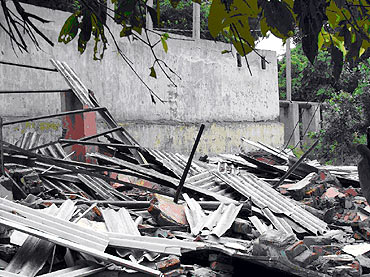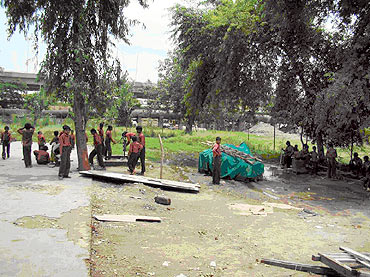Photographs: Manoj Misra Paranjoy Guha Thakurta and Ayaskant Das
As temples of post-modern India continue to be constructed out of concrete and steel and as the media frenetically highlights allegations of corruption and nepotism in the organisation of the XIXth Commonwealth Games, a tragedy quietly unfolded along the banks of the River Yamuna that was hardly reported and was soon forgotten.
On July 7, nearly 180 underprivileged children were deprived of their education and the livelihood of their parents permanently impaired, thanks to the sporting extravaganza that will take place in the national capital between October 3 and 14.
This is a story about those who once fed the citizens of New Delhi, and their offspring. That morning will forever be etched in the minds of the children who studied in a ramshackle school located on the flood plains of the river that cuts through the country's capital.
Dozens of officials of the Delhi Development Authority, some of them on bulldozers, reached the site of the school accompanied by a posse of police personnel.
The children of farmers who grew vegetables on the fertile riverbank and their teachers appealed with folded hands. But the officials were unmoved. They went about their assigned task with clinical efficiency.
The school kids did not even have the time to salvage their belongings: books and stationery. The school had to be demolished, together with the hutments of the farmers. Why? They could have posed a 'security threat' to the Games village located not very far away!
The school had been started in 2006 by an unusually motivated farmer couple. It had been functioning out of temporary sheds. Teacher Dheeraj Singh who witnessed the demolition told Rediff.com: "We had earlier proposed to officials of the DDA that we would voluntarily shut down the school for three months before and after the Games but they didn't listen to us."
The school had been functioning reasonably well over the past four years. The children attended their classes regularly, the school premises were kept clean and doctors would come in regularly and conduct medical examinations on the students.
Above all, everything was free -- no tuition fees had to be paid and teachers' salaries were taken care of.
Eight of the 180 children had been promoted from the elementary level and had qualified for admission to Class VI in a larger school run by the Municipal Corporation of Delhi. All of that was to change forever on July 7.
The DDA was far from impressed that government land had been encroached upon, no matter for what laudable purpose. Rajesh Prasad, Commissioner, Land Management, DDA, was blase when asked by Rediff.com why no notice had been served before the school building was demolished: "School or no school, we do not need to serve a notice before removing anyone squatting on government land."
He added that the Delhi high court had constituted a committee under Justice Usha Mehra that had given clear directions for removal of all new construction that had encroached on the floodplains of the Yamuna. That was it.
Did the DDA serve the interests of a real estate firm at the expense of the underprivileged?
Image: All that was left of the schoolPhotographs: Manoj Misra
Master Baljeet Singh, secretary general of the Delhi Peasants' Multi-purpose Cooperative Society, a society that had signed an agreement with the Delhi Improvement Trust, the predecessor of DDA, way back in 1949, told Rediff.com: "At least 1,000 people used to obtain direct or indirect employment by growing vegetables here but their livelihood has now gone."
The DDA, an autonomous body under the Union ministry of urban development, has entered into a public-private partnership with a real estate corporation called Emaar-MGF, which is a joint venture between Emaar Properties PJSC of Dubai and MGF Development Limited of India.
The company has obtained the contract to build the Games village, ironically, along the same floodplains of the Yamuna in the teeth of opposition from representatives of environmental groups who had contended that the construction of the village would constrain water supply to Delhi and disturb the ecological balance of the area making it more prone to flooding.
Manoj Misra, convenor of Yamuna Jiye Abhiyaan, a civil society organisation fighting for the conservation of the Yamuna river system, said: "The DDA went out of its way to build the Games village along the river-bed. It had commissioned the National Environmental Engineering Research Institute to prepare a feasibility report but ignored its findings."
Misra claimed that the DDA had not merely ignored NEERI's findings but had also not adhered to the recommendations of a committee set up by the Union ministry of environment and forests that examined the feasibility of constructing the Games village in the area.
The DDA, however, maintains that it has received proper environmental clearances and that construction began only after a go-ahead was granted by the Supreme Court.
Activists like Misra, a retired officer of the Indian Forest Service, point out that the DDA has blatantly served the interests of a privately owned real estate firm at the expense of the underprivileged.
Till the middle of October, the 'state-of-the-art' village would be under the charge of the Organising Committee of the Commonwealth Games and utilised for lodging an estimated 8,000 athletes and officials from across the world.
Thereafter, the flats would be occupied by the well-off who have already purchased the properties for occupation after the middle of October.
"Neither the farmers nor their children posed any kind of a security threat," Misra told Rediff.com, adding that, on the contrary, with their school getting demolished, some of the children may turn to a life of crime.
Was the so-called security threat orchestrated because some felt the jhuggis would be eyesores?
Image: Children at the site of their demolished schoolPhotographs: Manoj Misra
Misra, on the other hand, argues that the DDA had 'no legal, moral and ethical rights' to demolish the school and the hutments of the cultivators. The manner in which the school building and the hutments of the farmers were destroyed was 'extremely brutal and uncivilised', he added.
Prasad of the DDA, however, claimed that the temporary lease deeds were of a duration of ten years each and had been signed by officials of the Delhi Improvement Trust with two societies -- the Jheel Khurenja Milk Producers' Society and the Delhi Peasants' Multi-purpose Cooperative Society -- in 1949.
The deeds had expired a long time ago and since the lease agreements had not been extended, the demolition was not just legal but inevitable as well.
The Games village, spread over an area of 63.5 hectares, is being built at a total cost of around $230.7 million (the official figure). It has 14 blocks, 34 towers and 1,168 air-conditioned flats.
The chairman of the Organising Committee, Suresh Kalmadi, said during a television interview that the village is going to be 'the best in the world and is even better than the one (that was built for the 2008 Beijing Olympic Games) in China'.
Was the so-called security threat orchestrated because some felt that the jhuggis and the school would be eyesores for foreigners who visited India during the Games?
Why did the DDA not, in the very least, make arrangements to shift the school to an alternative location?
The callousness of the authorities stand out in stark contrast to the fact that the DDA has forked out a sum in excess of Rs 700 crore (Rs 7 billion) to the cash-strapped Emaar-MGF by purchasing an additional 333 flats over and above what had been earlier agreed upon.
Incidentally, Emaar-MGF had sought a Rs 1,000 crore (Rs 1 billion) bail-out loan package after real estate companies in the country were adversely affected by the economic downturn.
The DDA's actions appear strange to say the least when spokespersons of the Union government are shouting themselves hoarse about the need to operationalise the Right to Education Act that has been made into a fundamental right.
Dunu Roy, director, Hazards Centre (an organisation that aims at providing alternate, participatory frameworks on development policy, planning and practice), told Rediff.com: "The urban development model followed in Delhi is all about the entitlements of the rich and not the poor since it is heavily loaded in favour of the propertied and the salaried classes," before sarcastically adding: "Those who do not own property have been completely excluded from Delhi's Master Plan."




article